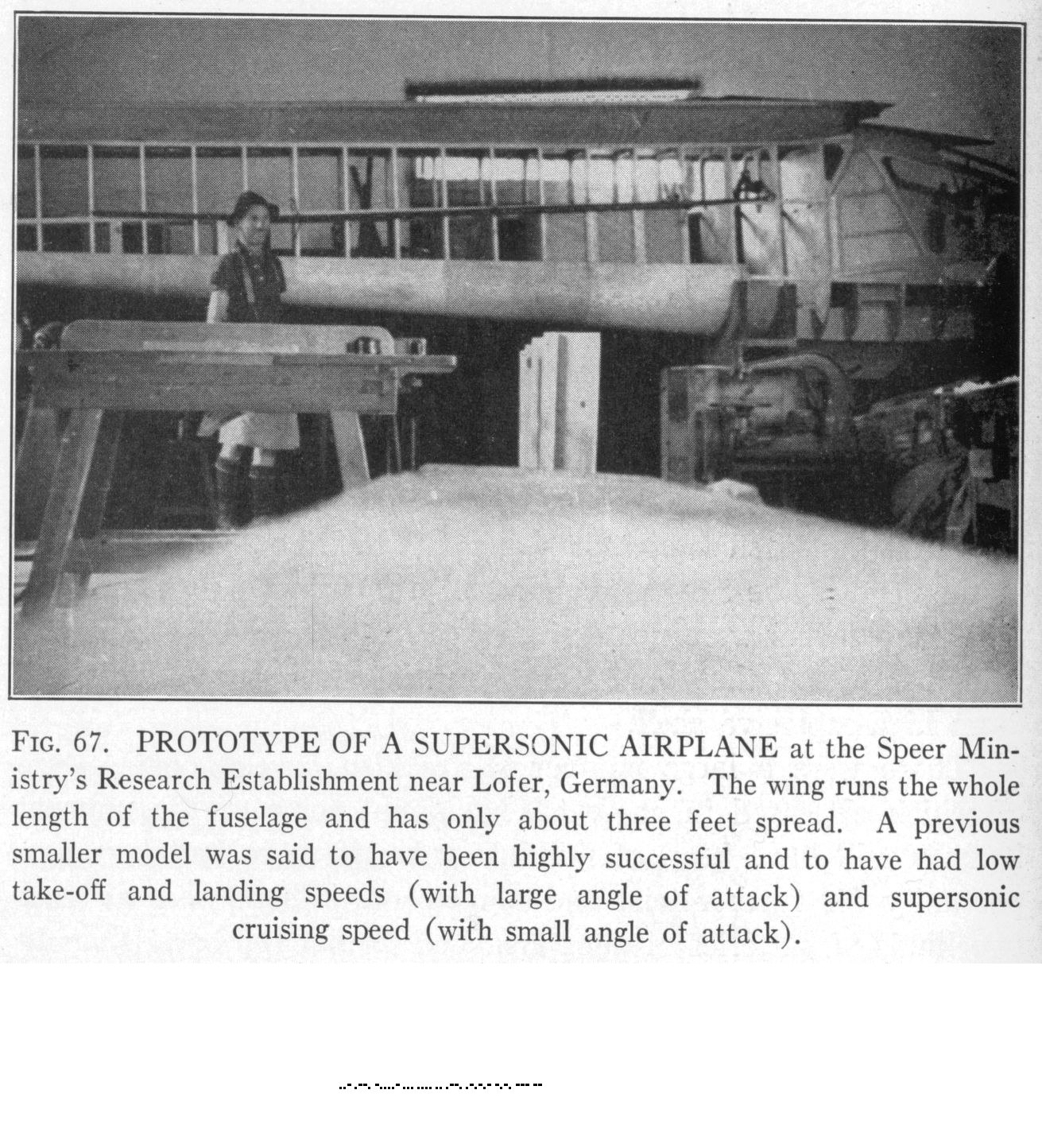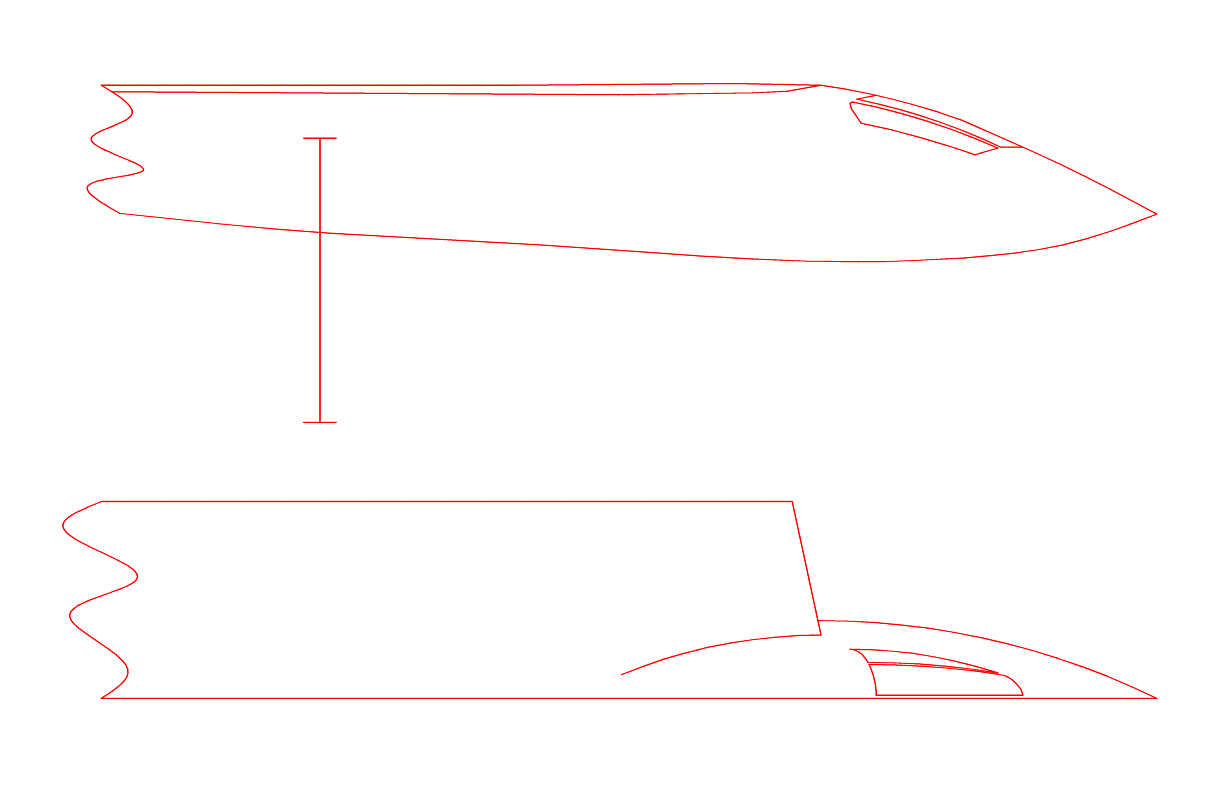Illustrated by a single photo in the book “German Research In World War II” (by Colonel Leslie Simon of the US Army Ballistic Research Labs, published 1947) is either a mockup or an incomplete wooden prototype of a supposed supersonic aircraft. The photo does not show the full length of the aircraft, lopping off both the nose and the tail. Trying to figure out just what the hell is going on here is somewhat of a problem. I made a cheesy attempt at reconstructing the design (sans tail) based on the single photo. Could easily be dead wrong. If anyone has additional info, I’d like to see it.
This likely is related to the supposed work of one Dr. Zippermayr in developing an aircraft called the “Pfiel” (Arrow), which featured a similarly stubby wing. Zippermayr’s post-war interviews with the US military are discussed here.
12 Responses to “The Lofer Mystery Plane”
Sorry, the comment form is closed at this time.




The part that annoys me is the statement about “angle of attack” of the wing being different for different speeds. Does that mean the angle of incidence of the airfoil can be altered in flight? I don’t recall any German designs that had control of the angle of incidence of the wing. Consider, however, these two from Luft’46:
http://www.luft46.com/mess/mep1109.html
http://www.luft46.com/bv/bvp202.html
Astronauitix offers this:
http://www.astronautix.com/craft/lofcraft.htm
It sounds somewhat similar, but the image is gone. I sent a note inquiring about the image.
What else was studied at the Lofer research institute? I found no reference to Lofer in William Green’s book, and it doesn’t appear in a couple of books I have on the rocket program. Lofer, by the way, is in Austria, but right on the border with Germany and the Czech Republic.
I tried a reconstruction of it many years back (even built a 1/72nd scale model of it) and came up with just about the same thing you did, with the exception that my wing had a forward-swept leading edge.
(I think that thing visible just ahead of and below of the starboard wing leading edge is the port wing leading edge).
Some have speculated that this is related to Sänger’s Antipodal Bomber, but the fuselage shape tapers, and that wouldn’t be right.
Whatever it is, it seems to have fallen through the cracks regarding known German secret aircraft designs, although rocket propulsion seems likely for something like this….or it might just be a glider.
The guy in the lederhosen just makes the photo. 🙂
> Does that mean the angle of incidence of the airfoil can be altered in flight?
No, it just means that the plane would land (and fly, at low speed) at a disturbing angle.
> What else was studied at the Lofer research institute?
If this is the same place where Zippermayr worked, then you also get the “sound canon,” the “tornado bombs,” and other supervillainish (meaning both cool, yet wholly impractical) weapons.
> I think that thing visible just ahead of and below of the starboard wing leading edge is the port wing leading edge
Were that the case, then the port wing would have a ridiculously forward sweep angle far in excess of the starboard. More likely it’s just a sheet of plywood in the background.
That photo has had me puzzled for decades. The only thing that I have learnt is that Lofer is in Austria and not Germany.
Mike
Finally the Lofer Mystery Craft it is not so much a mystery!!!!
One thing: early German rocketry did a lot of work about rockets wtih retractable wing, exactly as the dubbed Pfiel.
Starting by that I have a question: could it be a sort of second stage rocketplane to be placed atop an A4 (or better an A10)??
In this scenario the wholly retracteable wing has more sense…..
Further comment. Is it possible that the caption is wrong for that photo? It has happened before. The text,”… low take-off and landing speeds (with large angle of attack) and supersonic cruising speed (with small angle of attack)” seems to be a fair description of a delta aircraft. Looking at that photo I have always seen the high aspect ratio wing of a glider propped up against the wall.
As an aside, Hergé, the creator of the Tintin comic books, had a reputation for seriously researching the background to his stories. Simon’s book features in “L’Affaire Tournesol” and Hergé’s story is about the sound projector, also studied at Lofer. I also wonder if the red and white chequered rocket on the dust jacket of “German Research in World War II” served as inspiration for the red and white rocket in Hergé’s “Objectif Lune”.
Mike
About ” I also wonder if the red and white chequered rocket on the dust jacket of “German Research in World War II” served as inspiration for the red and white rocket in Hergé’s “Objectif Lune”.” the book front page is clearly showed in the own comic book! (In “L’Affaire Tournesol”, I think last pages).
Many clear images here: https://www.google.es/search?q=german+research+in+world+war+ii+tintin&safe=off&hl=en&biw=1093&bih=474&tbm=isch&tbo=u&source=univ&sa=X&ei=5oCYVK7YENjmavaCgYgE&ved=0CEkQsAQ
> could it be a sort of second stage rocketplane to be placed atop an A4
Not made out of wood it’s not.
Even if Zippermeyr *wanted* to put his plane atop an A-4… he was, more or less, “just some guy.” I could build a plywood lifting body in my shed, and make claims that it’s a test vehicle for a spaceplane to be put atop an Atlas V… but unless the USAF or NASA actually ponies up the cash to make that happen, my claims are just so much Popular Mechanix rubbish.
As to this being a retractaable wing… there’s no evidence of the mechanisms required nor the substantial structural modifications that would be needed. It just looks like a thin shoulder mounted wing of extremely short span, like the “Pfiel.”
I think you’ve got it nailed with the Zippermayr Pfiel; that does indeed look like it, and the Austrian location is correct also.
This basic concept has been tried several times through the history of aircraft, but engine torque in the piston and jet powered concepts would spin them out of control once speed got low, and the control surfaces on the short-span wings wouldn’t have enough of a moment arm to correct for it.
That’s probably what the high-mounted wing is all about; so the fuselage will hang under it and not roll side to side by keeping the center of gravity very low.
One problem is how to do the landing gear, as you are going to be touching down on your tail wheel, and there would be a real tendency for the front to slam down hard once the angle of incidence drops and the lift of the wing decreases as a result.
Another problem is that drag during final approach will be very high due to the severe angle the aircraft will be at, and once you are committed to landing you _are_ going to be landing, unless that jet engine can generate more thrust than the aircraft weighs…as the wing will be in a fully stalled condition.
> Not made out of wood it’s not.
Of course not at all.
I was only thinking about a wooden mock-up or so on or, in alternative a wooden prototype meant only for low speed test and also for test the wing deployment mechanism.
True, it is well some base model for the Zippermayer “high speed jettisonable supersonic fighter. Some German historian researcher, friend of mine , showed the full Popular Mechanics 1947 sketch with Mario Zippenmayer with his rubber-propelled little folded wings . It is quite probable the craft was intended to be ramjet runned , a domain fully explored by the fecond spirit of Eugen Sänger, first in Trauen-Fassberg (Lünebürger Heide), and then Ainring, not far from Lofer. The ramjet solution was first explored on a Dornier 217, as blueprints for the Skoda-Kauba P14, tricycle-launched spot defender, and from 1947, in the Southern of Paris (Fort de Châtillon) for the Nord Griffon. Except for this last, first started with usual Atar tjet, the violent accelelration to proppel these hollow-tube fighters, would have put the pilot’s life in serious danger with 10 to 12 Gs. Saenger also draw blueprints for the Heinkel P1080 and a quite hugly twin ramjet version of a (supposed ) supersonic Me 262